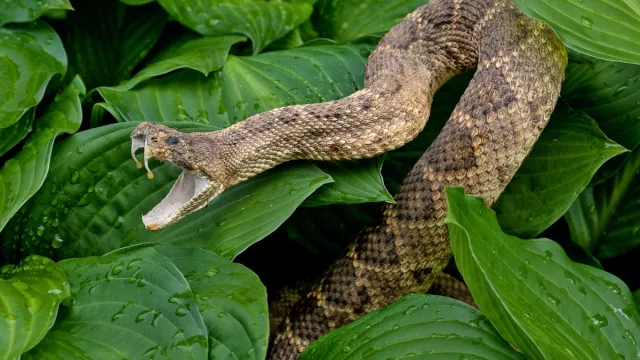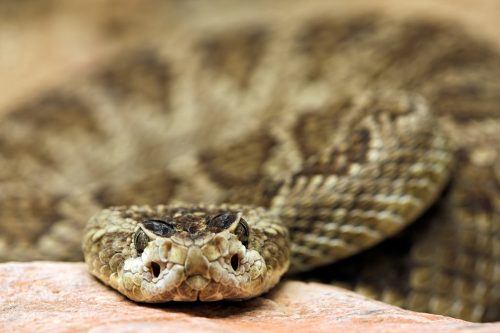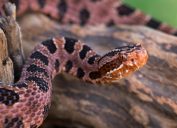Rattlesnake Attack Has Trauma Doctor Issuing a New Warning
He wants to make sure you know what to do and what not to do if you get bitten.

Just seeing a snake is enough to send many of us into a panic. But being bitten by one—particularly a venomous snake—is another story altogether. There have been numerous accounts of people across the U.S. being struck over the last few months, and that's no surprise: Researchers say venomous snake bites are actually increasing. Now, a recent rattlesnake attack has one trauma doctor issuing an important warning to the public. Read on to discover what you should and shouldn't do if you find yourself bitten by one of these deadly creatures.
RELATED: 20 Rattlesnakes Found in Man's Garage—Here's Where They Were Hiding.
An Amazon delivery driver was recently bitten by a rattlesnake.

A 21-year-old woman is currently recovering in the hospital after she was attacked by a rattlesnake while delivering Amazon packages in Palm City, Florida, local NBC-affiliate WPTV reported. Monet Robinson was rushed to Cleveland Clinic Martin North on Sept. 18 after being bitten on the inside of her upper thigh.
In a Facebook post, the Martin County Sheriff's Office said that Robinson was attacked by an Eastern Diamondback rattlesnake that had been coiled up near the front door of a home.
"The driver walked to the door, put the package down and was struck by the snake in the back of the leg, just above the knee," the department stated.
RELATED: 15-Foot Invasive Pythons Are Moving North From Florida and Can't Be Stopped.
These snakes are "highly venomous."

The Martin County Sheriff's Office said that Robinson is in "serious condition" after the attack.
"She immediately became ill and called 911," the department stated in its Facebook post. The Sheriff's Office also noted that Eastern Diamondback rattlesnakes are "highly venomous snakes and are very common" to the Palm City area.
In fact, this species of snake is North America's "longest, heaviest venomous snake," according to the Smithsonian's National Zoo and Conservation Biology Institute. "It's known for its iconic rattle and its venomous bite, which can be fatal to humans," the institute explains on its website.
RELATED: 17-Year-Old Bitten by Rattlesnake in His Home—Where It Was Hiding.
A trauma doctor is sharing what happens to your body when you get bitten.

Robert Borrego, MD, the trauma medical director at St. Mary's Medical Center in West Palm Beach, has been treating patients for more than three decades, and has seen several snake bites. In a new interview with local ABC-affiliate WPBF, he broke down exactly what happens to the body after someone is bitten by an Eastern Diamondback rattlesnake.
"The pain spreads up the extremity, and you get discoloration to the point where within the skin and muscle starts necrosing or dying off. And you'll see the wound progress rapidly," he told WPBF.
The toxin in this snake's venom—which is called hemotoxin—kills red bloods cells and causes tissue damage, according to the National Zoo and Conservation Biology Institute.
He says it's important to know what to do and what not to do.

After being bitten by the rattlesnake, investigators said Robinson remained calm while calling 911—something Borrego said is essential.
"The worst thing you can do is get excited or walk fast or run," he told WPBF. "Then, the blood circulates faster, and the venom gets distributed to your body faster."
If you can make it to a hospital or otherwise seek medical attention quickly, you should treat your bite with soap and water, and then apply a pressure bandage, according to Borrego. But if you can't get to the hospital right away, the trauma doctor advised a different protocol.
"If you can't get help soon with the rattlesnake, then you shouldn't put a pressure bandage because you're locking in the poison in that extremity and it's going to cause more damage in that extremity," he warned.
RELATED: For more up-to-date information, sign up for our daily newsletter.





















